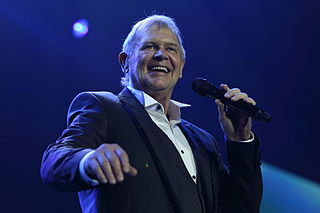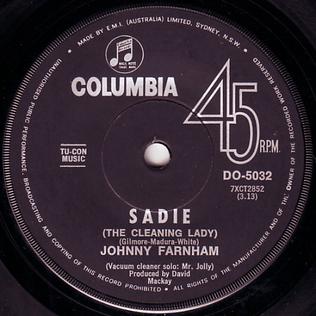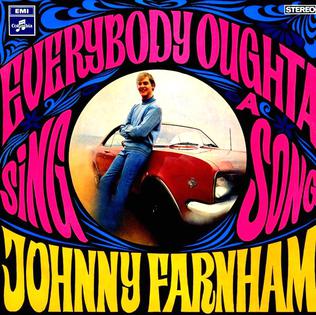
John Peter Farnham AO is a British-born Australian singer. Farnham was a teen pop idol from 1967 until 1979, billed then as Johnny Farnham, but has since forged a career as an adult contemporary singer. His career has mostly been as a solo artist, although he replaced Glenn Shorrock as lead singer of Little River Band from 1982 to 1985.
Rock music in Australia, also known as Oz rock, Australian rock and Aussie rock, is rock music from Australia. The nation has a rich history of rock music and an appreciation of the roots of various rock genres, usually originating in the United States or Britain, but also continental Europe, and more recently the musical styles of Africa. Australian rock has also contributed to the development of some of these genres, as well as having its own unique Australiana sound with pub rock and its indigenous music.
Peter William Dawkins was a New Zealand record producer and musician, best known for his late-1960s to mid-1970s New Zealand hits and his 1970s productions for Australian-based pop artists, including Dragon, Australian Crawl and Air Supply. He won multiple production awards, including the Countdown Producer of the Year. In the late 1980s, he developed Parkinson's disease.

The Twilights were an Australian rock band that formed in Adelaide in 1964. Alongside The Easybeats and The Masters Apprentices, The Twilights are widely considered to be one of the most significant Australian rock groups of the 1960s. During their run, they were noted for being on top of current musical trends, regularly covering British and American rock hits in their early repertoire. Their first hit was a cover of the Velvelettes' song "Needle In A Haystack", which made the top 10 in every state in Australia in late 1966.
Tamam Shud is an Australian psychedelic, progressive and surf rock band, which formed in Newcastle in 1964. The initial line-up were known as Four Strangers with Eric Connell on bass guitar, Dannie Davidson on drums, Gary Johns on rhythm guitar and Alex "Zac" Zytnik on lead guitar. At the end of that year Johns was replaced by Lindsay Bjerre on guitar and vocals as they trimmed their name to the Strangers. By late 1965 they had become the Sunsets. They took the name Tamam Shud in late 1967 after replacing Connell with Peter Barron on bass guitar. The group released two albums, Evolution (1969) – after which Tim Gaze replaced Zytnik on lead guitar – and Goolutionites and the Real People (1970) before disbanding in 1972. After a lengthy hiatus they reformed in 1993 to release a third album, Permanent Culture in 1994, but disbanded again in 1995. Beginning in 2008 the group worked together periodically on new material: it took eight years to complete their fourth album, Eight Years of Moonlight.

"Sadie " was Australian pop singer Johnny Farnham's first solo single. The novelty song was released in November 1967 and was No. 1 on the Go-Set National Singles Charts for five weeks in early 1968. It was the largest selling single in Australia by an Australian artist in the 1960s. The single, "Sadie" sold approximately 180,000 copies in Australia, and was also released in New Zealand, Denmark and Germany. The B-side, "In My Room" was written by Farnham. The A-side's label includes the acknowledgement "Vacuum cleaner solo: Mr. Jolly".
Sunshine Records was an Australian independent pop music record label of the mid-1960s. It was established in late 1964 by promoter Ivan Dayman in collaboration with musician-producer-arranger-songwriter Pat Aulton and entrepreneur, producer and songwriter Nat Kipner. Although his enterprise was short-lived, Dayman was arguably the first Australian popular music entrepreneur to create a fully integrated pop music company that included artist management and bookings, record production, record labels, venue management and concert promotion.
Mark Opitz is an Australian record producer and audio engineer. He was born in Melbourne, Australia, in 1952 and moved to Brisbane in 1959 spending his teenage years there. He is a childhood friend of Kym Gyngell.

An audio engineer helps to produce a recording or a live performance, balancing and adjusting sound sources using equalization, dynamics processing and audio effects, mixing, reproduction, and reinforcement of sound. Audio engineers work on the "technical aspect of recording—the placing of microphones, pre-amp knobs, the setting of levels. The physical recording of any project is done by an engineer ... the nuts and bolts."
David Mackay is an Australian record producer, arranger and musical director. He began his music career at the age of 15 in a production of Bye Bye Birdie for J. C. Williamson Theatre Company. He also worked for a time recording musical sessions for local radio.
The 13th Australian Recording Industry Association Music Awards was held on 12 October 1999 at the Sydney Entertainment Centre. Hosted by Paul McDermott and Bob Downe, and presenters, including Mel C of the Spice Girls, Tina Cousins, Fiona Horne and Molly Meldrum, distributed 33 awards. The big winner for the year was Powderfinger with four awards.

Everybody Oughta Sing A Song is the second solo studio album by Australian pop singer John Farnham and was released on EMI Records in November 1968. Its first single, released in July, was the double A-sided, "Jamie"/"I Don't Want To Love You", which peaked at No. 8 on the Go-Set National Singles Charts. The second single, "Rose Coloured Glasses" was released in October and peaked at No. 16. Writers on the album included Hans Poulson, Neil Diamond and Quincy Jones. The album was re-released in 1974 with a different cover, it shows Farnham performing live on stage, whereas the initial 1968 release had him leaning against a Holden Monaro.
Howard Gable is a New Zealand-born Australian record producer who is best known for his work as an A&R manager and house producer for EMI's Columbia pop label in Australia in the late 1960s and early 1970. He was also for some years married to New Zealand born pop/country singer and former Australian 'Queen of Pop' Allison Durbin.
The Masters Apprentices were an Australian rock band fronted by Jim Keays on lead vocals, which formed in 1965 in Adelaide, South Australia, relocated to Melbourne, Victoria in February 1967 and attempted to break into the United Kingdom market from 1970, before disbanding in 1972. Their popular Australian singles are "Undecided", "Living in a Child's Dream", "5:10 Man", "Think About Tomorrow Today", "Turn Up Your Radio" and "Because I Love You". The band launched the career of bass guitarist Glenn Wheatley, who later became a music industry entrepreneur and an artist talent manager for both Little River Band and John Farnham.
Paul McKercher is an Australian record producer, audio engineer, sound mixer and multi-instrumentalist. He has received five ARIA Artisan Awards and has produced over 50 albums. McKercher has worked with Australian artists Josh Pyke, Bertie Blackman, Papa vs Pretty, Sarah Blasko, You Am I, Pete Murray, Motor Ace and Eskimo Joe. An avowed analogue fan, he specialises in the use of tape, although he also uses digital technologies.

True Romantic – The Best of Kate Ceberano is a greatest hits album released by Australian recording artist Kate Ceberano. It was a commercial success, peaking at number 9 on the Australian Recording Industry Association (ARIA) album chart, and was certified platinum in Australia. The album was re-released in 2004, under the title The Definitive Collection.
Independent record labels proliferated in Australia during the 1960s. The local branch of the British-owned EMI company had dominated the Australian record market since the 1920s, but in this period it faced increasing challenges from its rivals, including the Australian arm of the American CBS Records and particularly from the Sydney-based Festival Records, a division of Rupert Murdoch's News Limited.

Colin John Loughnan is an Australian jazz saxophonist, teacher, and composer, best known as a member of the Delltones, Ayers Rock, Judy Bailey quartet, and as a teacher of saxophone at the Sydney Conservatorium of Music. Although Loughnan has long been associated with jazz music, the first nine years of his career were spent as a non-instrumental vocalist with vocal harmony groups The Crescents, and The Delltones starting in 1958. In the 60s, he learnt to play the saxophone, performing as an instrumentalist with Col Nolan and The Soul Syndicate, and as a founding member of the Daly-Wilson Big Band. At this time Loughnan was proficient in saxophones, flutes, and clarinet.
Ronald Stewart Tudor MBE was an Australian music producer, engineer, label owner and record industry executive. He started his career with W&G Records in 1956 as a sales representative; he became their in-house producer and A&R agent before leaving in 1966.
Darryl Lloyd Sambell was an Australian talent manager and music promoter from the mid-1960s. He managed teen pop idol, Johnny Farnham, for the early part of his career (1967–76), and for the Masters Apprentices (1968–69). In 1967 Sambell established the Australian Musicians Booking Organisation (AMBO), with fellow talent managers, Gary Spry and Jeff Joseph, to act as music promoters for their artists. He was a heavy smoker and was diagnosed with lung cancer in early 2001. He died of the disease later that year, aged 55.






